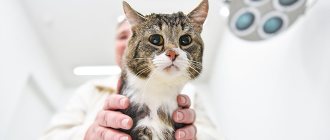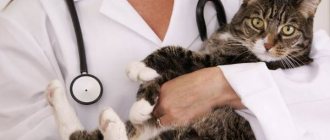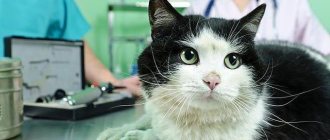Once again about the need to sterilize cats
In the 21st century, most pet owners know all about the need for castration for animals not involved in breeding. Veterinarians are less often asked why this procedure is needed, and even in online communities there are fewer disputes about this matter. It is obvious that modern society has set a course for a humane, caring attitude towards our smaller brothers, which includes caring for the health of pets and regulating the number of stray animals.
A domestic, uncastrated, sexually mature cat, whose owners periodically take it out to the countryside, over the summer can leave offspring numbering in the hundreds of furry babies for local cats. Most of the homeless kittens die from viral infections, frost and exhaustion, but the strongest ones survive and are ready to reproduce next year. Thus, the growth of the homeless cat tribe occurs in geometric progression.
Timely castration of domestic cats is not only concern for their health and peace of mind, but also a contribution to regulating the number of abandoned and stray cats.
The relationship between individual characteristics and sexual behavior of cats
Almost all sexually mature cats, regardless of whether they live in an apartment or free-range, strive to realize their sexual function. Sexual hunting, as a manifestation of the species’ desire to reproduce, is an integral part of the life of any adult mammal. This is an unconditional instinct, the implementation of which is closely related to the cyclical seasons, the availability of food supply and other components of the environment.
It is impossible to influence the reproductive instinct without the use of medications. Possessing a delicate sense of smell, animals become restless even when locked in an apartment and not seeing representatives of the other sex, but only catching the specific smell of hormones from an open window.
Many behavioral characteristics of cats are associated with the manifestation of sexual heat, which owners tend to associate with the character of their pet. This may be a tendency to wander, especially pronounced in free-ranging animals, or the creation of noise effects (screams, moans) when a cat in heat cannot realize its instincts because they are not allowed out of the apartment.
Also, owners sometimes believe that the animal defecates in the wrong places “out of spite”, after punishments and because of bad temper. Although in fact the reasons for aggression and such behavior are most often associated with the desire to mark one’s territory in order to scare away competitors and invite representatives of the opposite sex. Sometimes frequent urination in the wrong place can even indicate inflammatory processes in the urinary tract.
Therefore, at first glance, it is quite difficult to analyze the behavior of unsterilized animals and determine exactly which behavioral feature is associated with the desire to reproduce, and which with established habits.
Will sterilization help cope with animal aggression?
In some cases, owners bring their cat for surgery, finding themselves in a seemingly hopeless situation: they believe that sterilization will help “calm down” their overly aggressive pet. Does this theory have objective evidence?
Until relatively recently, even among veterinarians there was a belief that sterilization, by removing sex hormones from the body, actually helps make animals more manageable.
But cats are natural predators, and therefore aggression is inherent in their behavior from the very beginning. And nothing can be done about it. In any case, reducing the level of sex hormones will definitely not give much effect.
Important! If the operation is performed at about six months of age, the cat may actually become somewhat calmer. Or it may not be - it all depends on the character of the particular animal.
Sterilization is practically useless in calming initially aggressive animals. AND! Moreover, cats are often “out of their mind” and become even more aggressive when sterilized. The problem is that before the operation, some of the animal’s negative emotions manifested themselves in the form of sexual instincts, but after the operation the cat has nowhere to put its energy.
The conclusion is simple. You should not sterilize an animal if it behaves somewhat inappropriately. It is better to immediately explain the problem to the veterinarian. In many cases, a high-quality medical examination helps to identify the root cause of what is happening to the cat.
Perhaps the pet is in pain, something is bothering her (a tumor, for example), and therefore she rushes at people and shows her aggression in other ways. In addition, it is important to conduct a complete blood test. Often this behavior is caused by severe hormonal disorders. If they are identified in time and treatment is started, the animal will quickly become quite adequate.
Changing a cat's character after early sterilization
For the reasons described above, castration of an animal before the onset of puberty completely prevents behavioral characteristics associated with sexual hunting. If a kitten is neutered at 4-5 months, most likely he will not have the desire to leave odorous marks in the corners of his home. The animal will not have any interest in specifically attracting members of the opposite sex for reproduction.
An older, early sterilized cat will not exhibit those same endless estrus cycles that cause so much inconvenience and sleepless nights to their owners. Therefore, most often, no significant changes in behavior and character are observed in animals after early sterilization. All veterinarians recommend early castration precisely for this reason, as well as for the prevention of reproductive diseases.
Reasons for sterilization
Usually, a breeder does not think about a procedure that will deprive a cat of the opportunity to become a mother immediately after purchasing a kitten, which touches with its childish carefreeness. However, as the animal gradually matures, its behavior changes, and some of its characteristics may prompt the owner to carry out this procedure. The main reasons for sterilization are:
- Health risks associated with pregnancy and childbirth,
- The uncertainty of the fate of newborn kittens,
- Cats, like cats, mark their territory with urine,
- Prevention of cancer and infectious diseases of the genital area,
- Excited behavior of an animal during estrus.
It is the last factor that has the greatest influence on breeders, since the cat’s behavior after puberty turns a quiet kitten into a meowing and purring cat around the clock, and this will continue for 1-2 weeks, or until pregnancy occurs. This behavior is formed by ancient instincts of attracting a male, and only a change in the hormonal background after sterilization can correct this situation.
How do adult cats behave after sterilization?
Those owners who have decided to castrate because the animal constantly shows signs of estrus are most interested in the question: will the cat’s behavior change after sterilization? Will the cat stop being so noisy and aggressive?
There is no clear answer to this question. Obviously, after removal of the gonads, obvious manifestations of sexual desire will smooth out over time or even disappear completely. But if some features have become a habit for the animal and are fixed on a subconscious level, there is no guarantee that the cat will stop marking its favorite corner of the carpet. His desire to attract a beautiful cat will disappear, but the habit of regularly urinating in a convenient place may well remain.
Owners also often ask whether, after castration, the cat’s aggressive behavior directed at both relatives and members of the owner’s family (for example, biting and scratching) will stop.
This pattern of cat behavior after sterilization is for the most part not associated with sexual arousal, but with formed behavioral habits, multiplied by upbringing and hierarchy in the family. Therefore, after sterilization, you should not count on the rapid transformation of a cat, distinguished by its viciousness and savagery, into a tame, affectionate pet. Over time, due to a general decrease in activity, such a cat will most likely become calmer, but this cannot be expected to be a 100% guarantee.
Cat behavior immediately after sterilization
If the cat was operated on in a modern clinic, where a veterinary anesthesiologist monitors the administration of anesthesia and the awakening of the animals, the already awakened animal will be handed over to the owners. No signs of anesthesia (uncoordinated movements, unsteady gait, inappropriate behavior of the cat after sterilization) are no longer observed in such animals. It is enough to bring the cat home to a calm environment and leave it alone, preferably in a separate, quiet and darkened room.
On the first day after sterilization, the cat may be a little lethargic and sleep a lot, this is the norm for animals that have just been operated on. Often, having discovered that she is wearing a post-operative blanket, the cat tries to remove it, licks it and pulls at the places where the ties are attached. Also, if the strings were tied too tightly around the paws, the cat may find it uncomfortable to move, in which case it shakes all its limbs, crawls on bent paws, and even limps when walking.
It is very simple to check whether such signs are a manifestation of inconvenience or symptoms of some disease - just remove the blanket for a few minutes and see how the animal moves without it. Usually, when a cat is freed from its restraints, it immediately stops limping and bending to the floor. In this case, it is necessary to tie the ribbons of the blanket less tightly, but in no case should you leave the cat without a blanket after sterilization. In a few minutes without supervision, a cat with its rough tongue can lick a postoperative suture, damage and infect soft tissues.
The severity of the postoperative period largely depends on the age of the animal.
Khomutinnik Ekaterina Igorevna. Chief veterinarian. Specialization: soft tissue surgery, abdominal and thoracic surgery, endosurgery.
A few hours after the operation, the cat can already be offered food and water. It’s okay if she immediately refuses to eat or drink. Due to the stress caused by visiting an unfamiliar place and transport worries, many animals may demonstrate a decreased appetite. You can offer your cat wet food that has increased palatability; usually, even after surgery, animals willingly eat it. Once the animal understands that it has been returned to a familiar environment, it will gradually calm down and return to its usual way of life.
You should start to worry if, by the end of the first day after surgery, the cat refuses food and water, does not go to the toilet, and lies down all the time. In this case, you must immediately contact a veterinary clinic and bring the cat for examination, since such symptoms may be associated with complications after sterilization - hemorrhage in the abdominal cavity, an inflammatory process.
Vomiting, diarrhea, discharge from the eyes and nostrils are also symptoms that should not normally be observed after sterilization. Such signs may be associated with infection with infectious diseases in a clinic or public transport if the cat has not been vaccinated in advance.
Postoperative suture care
Before removing the suture, it should be treated with antiseptics. Do not use solutions containing alcohol. In this way, the operated tissues can be injured.
It is better to handle seams with the help of another person. This is necessary so that the animal does not twitch. One person should grab the pet under the front paws, while the other slightly lifts the blanket and processes the seam.
The cat continues to ask for a cat after sterilization
If after the operation the cat still shows signs of heat (arches, raises its tail, screams, meows), you should figure out how much time has passed. In castrated animals, residual amounts of sex hormones can remain in the blood for several weeks, causing corresponding behavioral characteristics. If such signs are observed for many months after sterilization, you should contact a veterinary reproductive specialist to diagnose ovarioreminant syndrome.
During the operation, the surgeon removes the entire ovary by placing a ligature (suture) on the ovarian ligament. If even a small amount of hormonally active tissue remains on the ovarian ligament (due to a surgeon’s error or the anatomical features of a cat, whose ovaries are not an even ball, but a rather scattered structure), then even from a small number of cells a section of tissue can grow that repeats the functions of the removed ovary. In this case, it is necessary to repeat the operation to remove hormonally active tissue. To diagnose ovarioreminant syndrome, you need to contact a veterinary reproductive specialist during the cat's heat. The doctor will take a cytological sample to determine the phase of the cycle, and may need to do an ultrasound examination.
Khomutinnik Ekaterina Igorevna. Chief veterinarian. Specialization: soft tissue surgery, abdominal and thoracic surgery, endosurgery.
If there are any changes in your cat's behavior after sterilization that seem unusual to you for your animal, you should consult your veterinarian!
The first hours after surgery
Upon arriving home after the veterinary clinic, a moment of shock comes for the cat's owners. They will have to watch their animal for a long time and help it survive this difficult period. A cat may fall when standing on its paws, it may not eat or drink well, it may become entangled in wires or be injured when bumping into a corner. To prevent this from happening, you need to remove all dangerous objects, place the cat on low furniture and place bowls of water, food and a tray near it. Try to protect the operated animal from children and other pets. The cat after the sterilization operation is still very weak; if it cannot drink on its own, water can be given to it from a pipette.
A few drops are enough, the main thing is to moisten your mouth and throat. It is better to organize a temporary warm bed for your pet, away from drafts. It is necessary to lay her on her right side, otherwise the load on the heart will increase several times. Do not be afraid of the animal’s unusual behavior. It is necessary to ensure that the animal sleeping after anesthesia does not choke on vomit.











